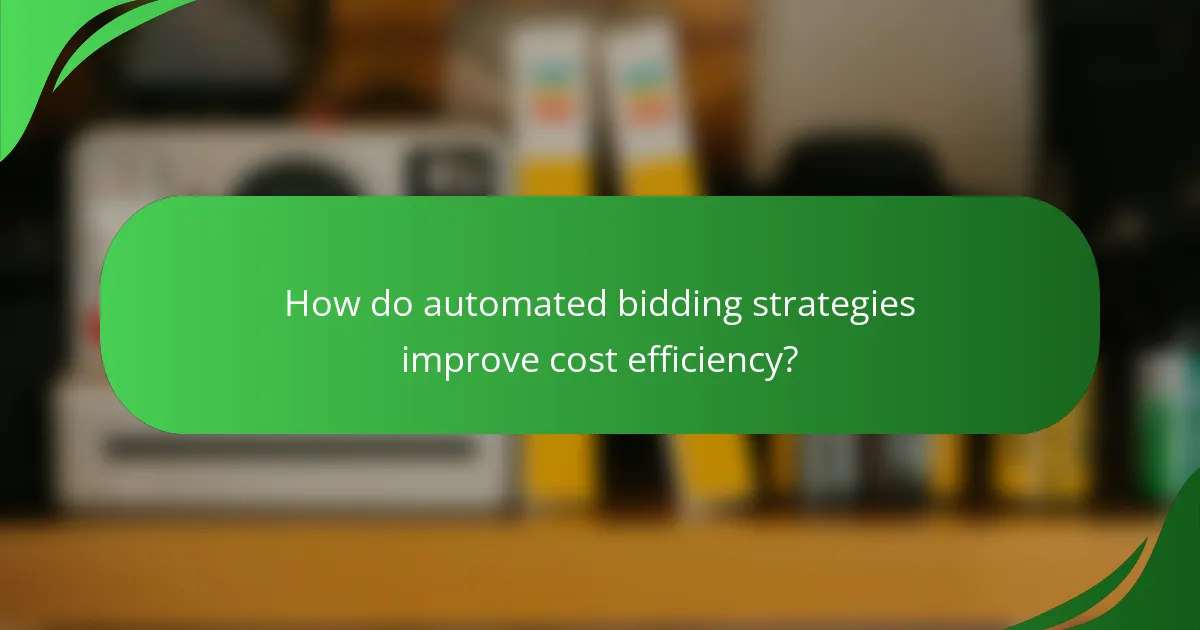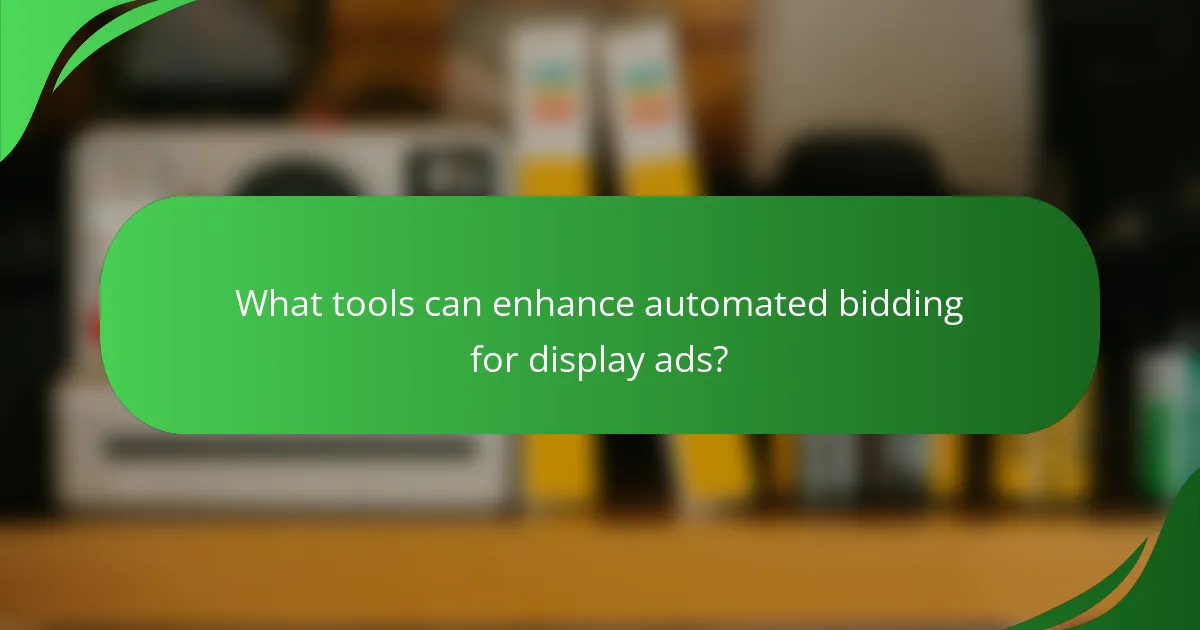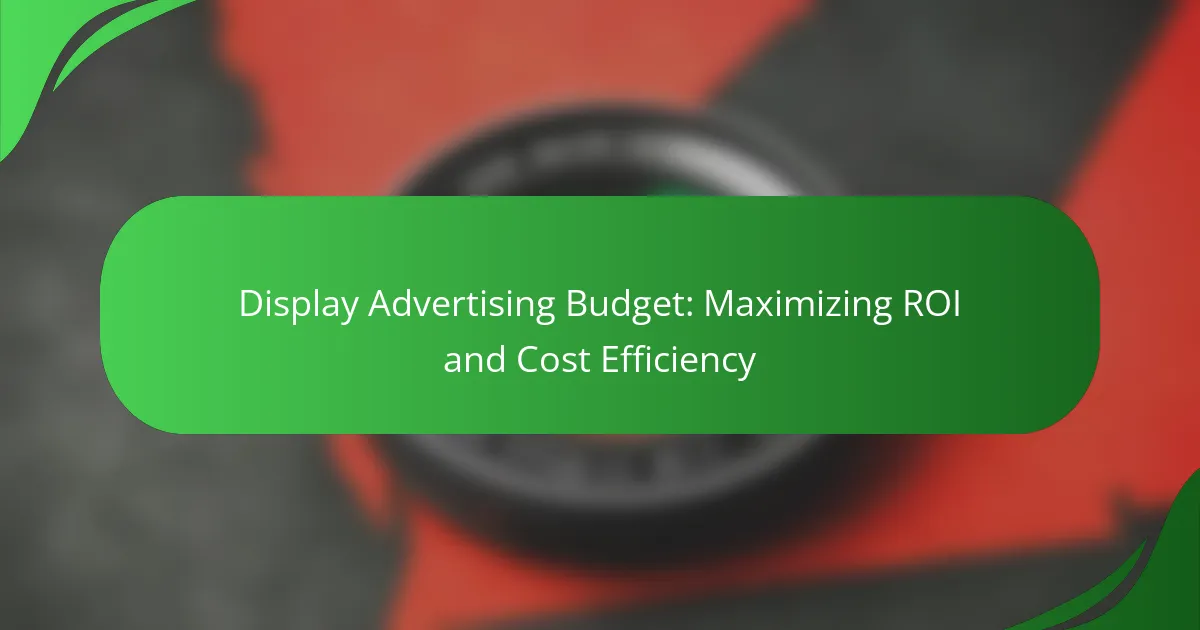Automated bidding strategies in display advertising are designed to enhance cost efficiency by utilizing machine learning to optimize bids in real-time. By reducing the need for constant manual adjustments, these strategies allow advertisers to focus on broader campaign objectives while maximizing their return on investment. Selecting the right bidding approach involves considering campaign goals, budget constraints, and target audience behavior to ensure optimal results.

What are the best automated bidding strategies for display advertising in Australia?
The best automated bidding strategies for display advertising in Australia focus on maximizing cost efficiency while achieving specific campaign goals. These strategies leverage machine learning to optimize bids in real-time, ensuring that advertisers get the most value from their ad spend.
Target CPA bidding
Target CPA (Cost Per Acquisition) bidding aims to achieve as many conversions as possible at a specific cost per acquisition. Advertisers set a target CPA, and the bidding algorithm adjusts bids to meet this goal based on historical data and real-time performance.
When using Target CPA bidding, it’s crucial to have enough conversion data for the algorithm to learn effectively. A common pitfall is setting an unrealistic CPA that may limit the number of conversions. Aim for a target that reflects your overall marketing budget and goals.
Maximize conversions bidding
Maximize conversions bidding focuses on obtaining the highest number of conversions within a specified budget. The algorithm automatically adjusts bids to achieve this goal, making it ideal for campaigns with a clear conversion objective.
This strategy works best when you have a defined budget and a clear understanding of your conversion value. However, be cautious of overspending; regularly monitor performance to ensure that the cost per conversion remains within acceptable limits.
Target ROAS bidding
Target ROAS (Return on Ad Spend) bidding is designed to maximize revenue based on a specified return on ad spend. Advertisers set a target ROAS, and the algorithm adjusts bids to achieve this return across campaigns.
To effectively use Target ROAS bidding, ensure you have accurate tracking of revenue generated from conversions. Setting a target that is too high can limit reach, while a lower target may not maximize profitability. Regularly review and adjust your target based on performance data.
Enhanced CPC bidding
Enhanced CPC (Cost Per Click) bidding allows for manual bid adjustments while leveraging automated features to increase bids for clicks that are more likely to convert. This hybrid approach helps balance control and automation.
When using Enhanced CPC, it’s essential to have a solid understanding of your conversion rates. This strategy is beneficial for advertisers who want to maintain some control over their bids while still taking advantage of automated optimizations.
Maximize clicks bidding
Maximize clicks bidding focuses on generating as many clicks as possible within a set budget. This strategy is straightforward and works well for campaigns aimed at increasing website traffic.
While this approach can drive high volumes of traffic, it may not always lead to conversions. Be mindful of the quality of traffic and consider complementing this strategy with conversion-focused tactics to ensure that clicks translate into meaningful actions.

How do automated bidding strategies improve cost efficiency?
Automated bidding strategies enhance cost efficiency by leveraging algorithms to set optimal bids based on various factors. This reduces the need for constant manual adjustments and allows advertisers to focus on broader campaign strategies while maximizing their return on investment.
Reduces manual adjustments
Automated bidding minimizes the necessity for manual bid changes, which can be time-consuming and prone to human error. By using data-driven algorithms, these strategies automatically adjust bids based on performance metrics, ensuring that campaigns remain competitive without constant oversight.
This approach allows marketers to allocate their time and resources more effectively, focusing on creative aspects and overall strategy rather than getting bogged down in daily bid management. For example, a campaign can automatically increase bids for high-performing keywords while lowering them for underperformers.
Optimizes bids in real-time
Real-time optimization is a key feature of automated bidding strategies, allowing bids to be adjusted instantly based on current market conditions. This responsiveness helps advertisers capitalize on fleeting opportunities, such as increased demand during peak times or special events.
For instance, if a competitor raises their bid for a specific keyword, automated systems can respond promptly, adjusting your bid to maintain visibility. This dynamic approach can lead to better ad placements and improved click-through rates, ultimately enhancing cost efficiency.
Improves ad placement
Automated bidding strategies can significantly enhance ad placement by ensuring that bids are competitive enough to secure prime positions on search results or display networks. By analyzing historical performance and user behavior, these systems can predict the best bid for achieving desired placements.
For example, an automated system may prioritize bids for times when user engagement is highest, leading to better visibility and higher conversion rates. Advertisers can benefit from improved placements without needing to constantly monitor and adjust their strategies, resulting in a more streamlined advertising process.

What factors should be considered when choosing a bidding strategy?
When selecting a bidding strategy for display advertising, it’s essential to consider your campaign goals, budget constraints, and target audience behavior. These factors will help you determine the most cost-efficient approach to maximize your return on investment.
Campaign goals
Your campaign goals significantly influence the choice of bidding strategy. If your objective is brand awareness, a cost-per-thousand impressions (CPM) model may be suitable, while a cost-per-click (CPC) model is better for driving traffic. Clearly defining whether you aim for conversions, leads, or visibility will guide your bidding approach.
Consider setting specific, measurable goals to evaluate the effectiveness of your strategy. For example, if your goal is to achieve a certain number of conversions, you might opt for a target cost-per-acquisition (CPA) strategy to control costs while maximizing results.
Budget constraints
Your budget plays a critical role in determining which bidding strategy to adopt. Establish a clear budget range to avoid overspending and ensure that your strategy aligns with your financial limits. For instance, if your budget is limited, a CPC strategy may help you manage costs more effectively than a CPM approach.
Regularly monitor your spending and adjust your bids accordingly. If you notice that certain ads are performing well, consider reallocating budget towards those to optimize your overall campaign performance.
Target audience behavior
Understanding your target audience’s behavior is crucial when selecting a bidding strategy. Analyze data on how your audience interacts with ads, such as click-through rates and conversion rates, to inform your bidding decisions. For example, if your audience tends to engage more during specific times, consider adjusting your bids to capitalize on those peak periods.
Utilize audience segmentation to tailor your bidding strategy. By identifying different segments within your target audience, you can apply varied bidding strategies that cater to each group’s unique behaviors and preferences, ultimately enhancing your campaign’s effectiveness.

What are the prerequisites for implementing automated bidding?
To implement automated bidding effectively, businesses need to ensure they have adequate data and a reliable conversion tracking system in place. These elements are crucial for algorithms to optimize bids and achieve cost efficiency in display advertising.
Access to sufficient data
Having access to sufficient data is essential for automated bidding strategies. This includes historical performance data, user behavior insights, and conversion metrics. The more data the system can analyze, the better it can predict outcomes and adjust bids accordingly.
For example, if a campaign has only a few conversions, the algorithm may struggle to make informed decisions. Aim for a minimum of several dozen conversions per month to provide a solid foundation for the bidding strategy.
Clear conversion tracking setup
A clear conversion tracking setup is vital for automated bidding to function effectively. This involves defining what constitutes a conversion, such as a purchase, sign-up, or lead generation, and ensuring that tracking codes are correctly implemented across your website and advertising platforms.
Without accurate tracking, the bidding algorithm cannot assess the effectiveness of its bids, leading to inefficient spending. Regularly review and test your tracking setup to confirm that all conversions are being captured accurately.

What tools can enhance automated bidding for display ads?
Several tools can significantly improve automated bidding for display ads, focusing on optimizing cost efficiency and maximizing return on investment. Key platforms like Google Ads offer various automated bidding strategies that adjust bids in real-time based on performance data and user behavior.
Google Ads
Google Ads provides a suite of automated bidding strategies designed to help advertisers achieve specific goals, such as maximizing conversions or targeting a particular return on ad spend (ROAS). These strategies leverage machine learning to analyze vast amounts of data, adjusting bids based on factors like user demographics, device type, and time of day.
Advertisers can choose from options like Target CPA (Cost Per Acquisition), which aims to get as many conversions as possible at a set cost, or Target ROAS, which focuses on maximizing revenue relative to ad spend. It’s essential to monitor performance regularly and adjust settings based on campaign outcomes to ensure optimal results.
When using Google Ads, avoid setting overly restrictive bid limits, as this can hinder the algorithm’s ability to optimize effectively. Regularly review performance metrics and be prepared to tweak your bidding strategy based on seasonal trends or shifts in user behavior.



